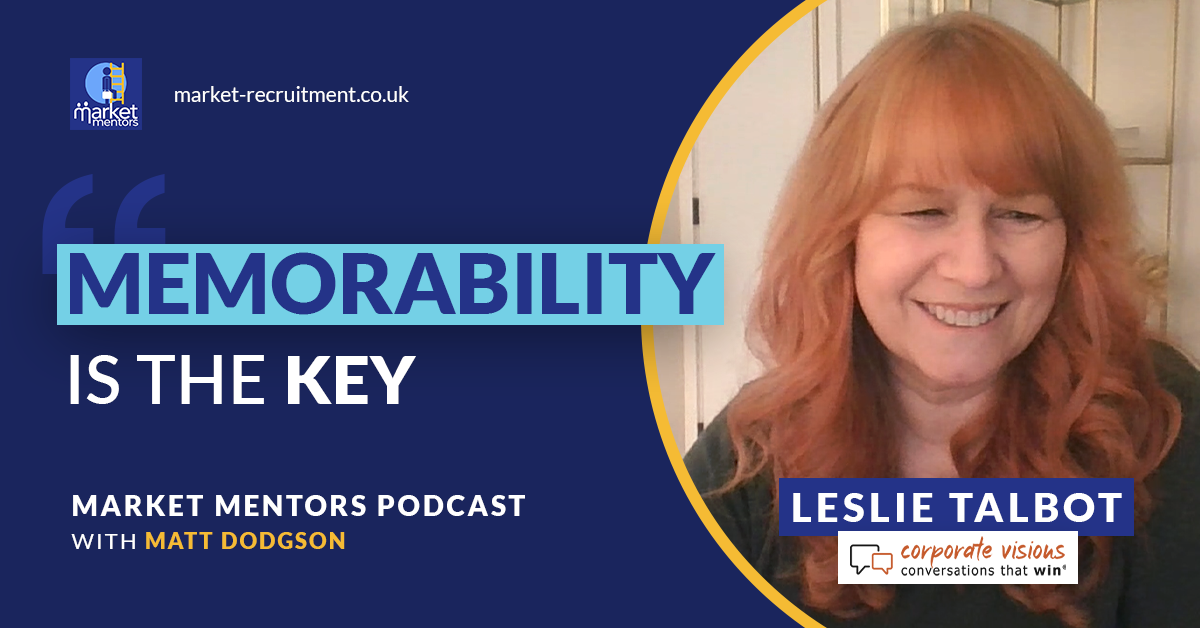
Good storytelling is essential for marketers to connect with our target customers, influence their behaviour, and inspire them to take action.
In this episode, Leslie Talbot talks to Matt Dodgson about the fascinating science behind storytelling and how it can be used to make marketing more effective.
Who they are: Leslie Talbot, Senior Vice-President of Strategic Marketing at Corporate Visions.
A bit of background: Leslie is passionate about using storytelling to help businesses sell more effectively. She has almost 20 years of experience in marketing, and has been with her current business, Corporate Visions, for 13 years.
Where you can find them:
Here you’ll find some of the best advice from the podcast that you can easily digest and learn from.
While marketing has changed a great deal in recent years, the fundamentals are still very much the same as they’ve always been.
Leslie believes there are four key skills any good marketer needs to have in order to be successful. These are:
Leslie said, “I feel like marketers have gotten away from the core of what it means to be a marketer recently, because we all get caught up in the data and the strategies and the tactics.”
“At the end of the day, what being a great marketer really comes down to is those four skills. That’s what I think about as the core of being a marketer, and they’re the time immemorial skills as well. They’re the stuff that we take for granted, almost, but we shouldn’t. And all the data and everything else all around it supports those four core skills.”
But that’s easier said than done, of course. As Leslie points out, around 80% to 90% of a buyer’s journey takes place online these days. And with more content, information, data, and general noise being made online than ever before, marketers face a huge challenge trying to ensure they stand out from the crowd.
To stand the best chance of connecting with your target audiences and converting them into customers, you must ensure your message is memorable. She said:
“The number one factor that influences a buying decision is memory.”
Leslie Talbot“People make decisions based on what they remember, not on what they forget. So, memorability becomes the core thing that you have to infuse into everything that you do as a marketer, because if they don’t remember, they can’t buy from you. It really becomes that simple. So first and foremost, memorability is the key.”
According to Leslie, it’s scientifically proven that, when reading content or consuming information, your audience will forget around 90% of what you tell them within 48 hours.
So, marketing content should be strategically planned, focused, and written with that remaining 10% of memory in mind.
Leslie explained, “You can’t make them remember any more than 10% but what you can do is control what the 10% is that they do remember. That’s what marketers need to understand, and that means stripping it down to its very core. What is the essence of that message? What is that 10% essence that you want them to remember? Find it and then repeat it again, and again, and again, and organise that piece of content around that 10% message.”
Another useful technique Leslie mentioned is to use the rule of three when producing content and delivering important marketing messages.
“For whatever reason, the brain remembers things in threes,” said Leslie. “So, we always try to come up with three pillars that support that 10% message. And then we organise the content into those pillars that then roll up into the 10% message.”
Once again, Leslie turns to science and psychology to inform her strategy for storytelling.
And what makes a great story that will inspire your target audience to take the desired action? Well, there are three scientific components to what makes a story effective. Those are:
Leslie explained, “There is science behind storytelling as well, and the idea of storytelling in business has caught on, and everybody talks about it, but I think people understand business storytelling a little bit differently.”
“Like when they think about business storytelling, they often think about it as a story about you, as a story about your solutions or your products. Maybe you have a case study in there and there’s a story about the case study. That’s what people tend to think of as storytelling, but at the end of the day, the business stories that you tell should be about your buyer.”
“Your buyer is the hero of the story, and you have to tell a story about their journey.”
Leslie TalbotLeslie also highlighted the importance of presenting your customers with details and points of value that are specific to them, rather than generic.
She said, “Our research shows that including the right ‘telling details’ in your story, which are tangible, concrete things your buyer is going to be able to do differently with your solution – not the benefits they’ll achieve, but the actions that they’re going to be able to take – increases the credibility and persuasiveness of a pitch by up to 95%.”
For example, don’t simply state that your overall audience will lower their operational costs by using your product. Instead, demonstrate to your prospects in the logistics industry that their lorry drivers will be able to type their destination into a GPS system and get the fastest route to the location. Those specific use cases are what will resonate and ensure you get your message across.
“That’s telling a concrete detail about what your buyer is going to be able to do that will result in lower operational costs,” said Leslie. “But you’re giving them the ability to make that connection themselves. And when they do that, that encodes the memory in their brain much more than you just telling them the high-level abstract idea.”
Subscribe to our fortnightly newsletter to hear about our latest podcasts, blogs, career advice & jobs.